Crypto Swing Trading Strategies: Minimize Risks and Boost Gains
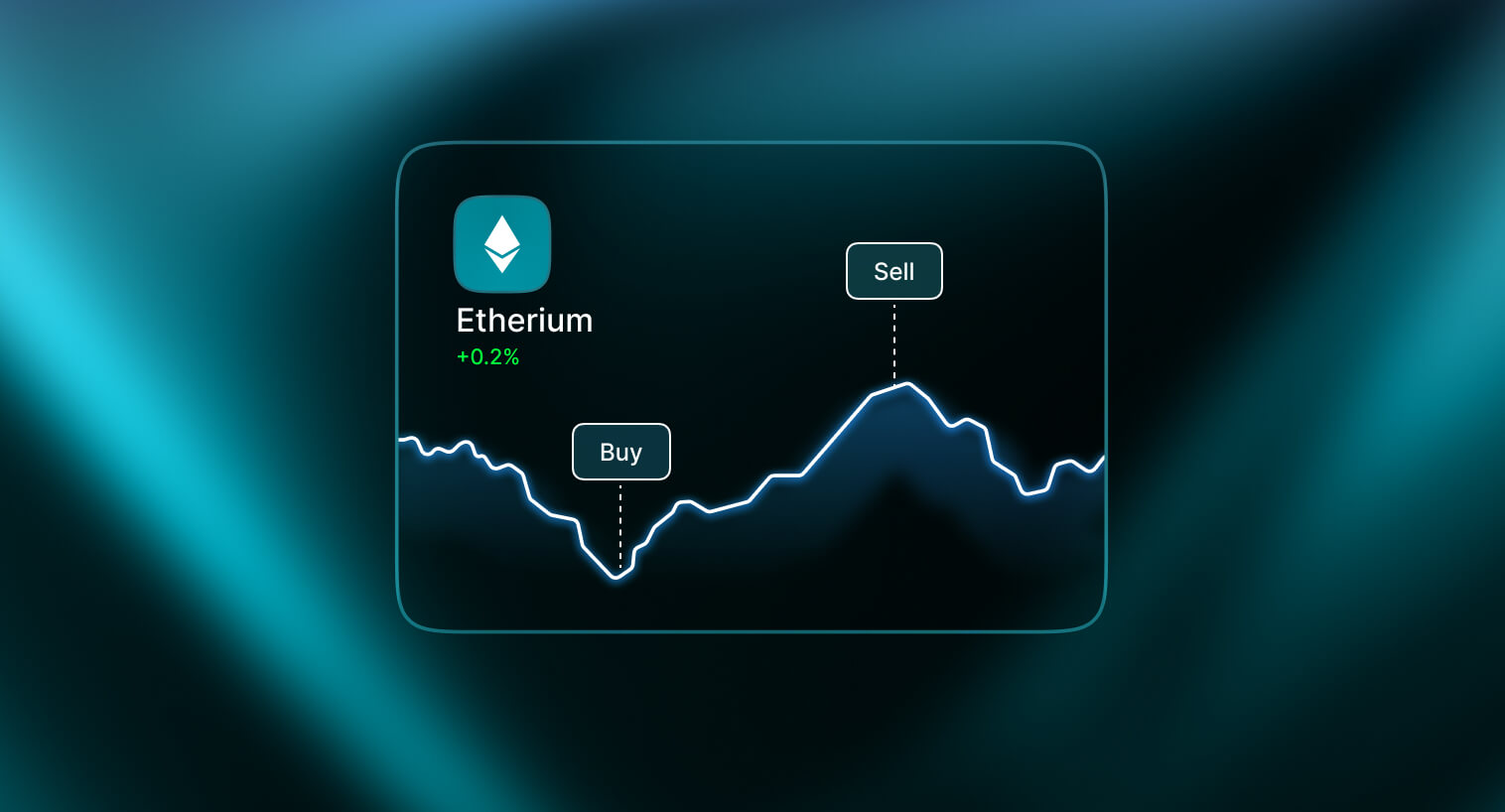

Swing trading in cryptocurrency is one of the best strategies to profit from short-term and medium-term price fluctuations in the crypto market. This approach focuses on using technical analysis to take advantage of price swings occurring over several days or weeks, leveraging the high volatility present in crypto markets.
While day trading requires constant monitoring and multiple trades within a single day, and long-term investing focuses on holding assets for months or years, swing trading offers a balanced approach that can be highly attractive for those with full-time jobs.
Swing traders can profit by finding optimal entry and exit points, buying low and selling high during a bull market, as well as selling high and buying low during a bear market. In this article, we will explore some of the best strategies to take advantage of cryptocurrency volatility and master crypto swing trading techniques.
Swing trading, although very common in the stock market, can also be a methodology for crypto trading focused on profiting from short-term and medium-term trends in cryptocurrency prices. Given the high volatility of the cryptocurrency market, this strategy is particularly attractive due to the opportunities it presents for profitable trades with Bitcoin and other digital currencies.
Crypto swing traders can plan their trades to capitalize on market reversals. They can buy crypto assets when crypto prices drop to lower support levels and sell when prices recover and rise over the next few days or weeks. They can also use trend-following strategies, waiting for pullbacks to enter an existing trend.
Cryptocurrency swing trading relies on monitoring price charts and market trends. To do this effectively, swing traders use technical indicators such as moving averages, the Relative Strength Index, and support and resistance levels to open and close positions. A well-defined trading plan, including backtesting and clear rules, is essential for swing traders, helping them execute trades that maximize profits while minimizing risks.
It is crucial to understand the nuances of crypto swing trading, crypto day trading, and cryptocurrency investing to choose an approach that aligns with your individual goals and risk tolerance. We must consider different time horizons and levels of engagement required for effective crypto trading, depending on the chosen method. The table below provides a comparative overview:
| Feature | Day Trading | Swing Trading | Long-Term Investing (Holding) |
| Timeframe | Hours to a day | Days, weeks, or even a few months | Months and years |
| Activity Level | Constant monitoring and very high engagement | Less frequent monitoring | Minimal monitoring |
| Potential Profit | Smaller but frequent gains | Larger but less frequent | Appreciation in the long term |
| Risks | Slippage, high-frequency trading risks | Overnight/weekend gaps, market volatility | Long-term market downturns |
| Psychological Burden | High stress, intense decision-making process | Less stressful, more space for thoughtful decision-making | Lower stress |
Generally, day traders employ full-time crypto trading. They can remain focused and decisive under extreme pressure and have a strong understanding of short-term technical analysis. A typical crypto day trader thrives in a fast-paced environment and profits from minor intraday price action.
Swing trading, on the other hand, offers an option for those who want to engage in the cryptocurrency market actively but cannot dedicate full-time hours to it. Swing trading requires analyzing trends and momentum over a few days to weeks, making it an ideal approach for those who wish to perform less frequent analyses.
Long-term investing – which the crypto community refers to as “hodling“ – is best suited for those who believe in the long-term potential of cryptocurrency and prefer a less active approach. The focus is on holding assets through market fluctuations without seeking quick profits from opening and closing positions.
Swing trading and day trading both offer opportunities for people who want to engage with the market for financial gains. The main advantage of swing trading, however, is that it requires much less constant monitoring, reducing psychological pressure and providing more flexibility for those with full-time jobs. By swing trading instead of day trading, traders can smoothly integrate their crypto trading activities into their routines, contributing to an effective albeit less time-consuming trading journey.
Although it offers a less stressful environment than day trading, swing trading also brings certain risks and pitfalls. Swing traders must remain aware of overnight and weekend gaps, where significant and explosive movements can occur while the trader is not monitoring the markets, increasing the risk of unexpected losses. The price of Bitcoin and other cryptos is heavily influenced by sudden news and events, impacting positions negatively if traders are not vigilant. Swing traders can also experience liquidity issues, especially with cryptocurrencies of lower market capitalization and trading volumes, making exiting positions at favorable prices a bit harder during volatile periods.
Higher trading capital is also recommended to swing trade effectively. Wider stop-loss orders are required when trading on weekly timeframes due to larger market fluctuations. Higher trading capital is also useful to cover trading fees.
Success in swing trading demands discipline and patience. Robust risk management is essential for successful cryptocurrency trading in all timeframes and horizons. Using appropriate stop-loss orders and position sizing is necessary for long-term survival in this highly volatile market.
To help traders reduce the risks in crypto swing trading by selecting the right coins, we have listed below the most suitable candidates for crypto trading in 2025. They are considered ideal mostly due to their liquidity, volatility, market capitalization, and trading volumes:
When choosing cryptocurrencies for swing trading, beginners should prioritize more established coins, focusing more on Bitcoin and Ethereum as they gain more experience and confidence in their skills. These coins have higher liquidity and offer a somewhat more predictable price action, allowing you to use technical analysis tools like the flag pattern and the ascending triangle pattern.
As you grow more confident and ready to explore more cryptocurrencies, it is important to get a higher understanding of their specificities and price patterns. Prioritize coins with high trading volume and larger market cap. You can use CoinGecko’s Top 100 Coins by Trading Volume to find a list of coins known for their higher trading volumes, higher volatility, and opportunities for swing trading.
Technical analysis is the core behind the development of profitable swing trading strategies. Technical analysts rely on price charts and indicators to identify trading opportunities at the most appropriate time. Crypto swing traders use specific time frames to watch for price action and entry signals, usually leaning on the 4-hour to the daily 1D charts. The 4-hour chart offers a short-term perspective on price swings, whereas the daily chart offers a longer-term view. Swing traders can use both in conjunction to identify trends and entry points.
Fundamental analysis, on the other hand, is the study of a company’s financial health, statements, industry, and indicators to determine its intrinsic value and measure future performance. Although primarily used in the stock market, it can also be adapted to the crypto market. Staying informed on the latest news, regulatory changes, and project updates is crucial for understanding the underlying factors behind price action. Project updates related to blockchain upgrades, new features, and adoption metrics can significantly impact a cryptocurrency’s price and trading volume, giving you an edge and a richer context into the asset compared to traders solely focused on price charts.
You can integrate the info you obtain from staying informed on the fundamentals with technical analysis to understand the why behind certain trends and price movements. It also gives you more confidence to open and close positions since you will have more to back your trading decisions.
Among the most used technical indicators for cryptocurrency swing trading, we have:
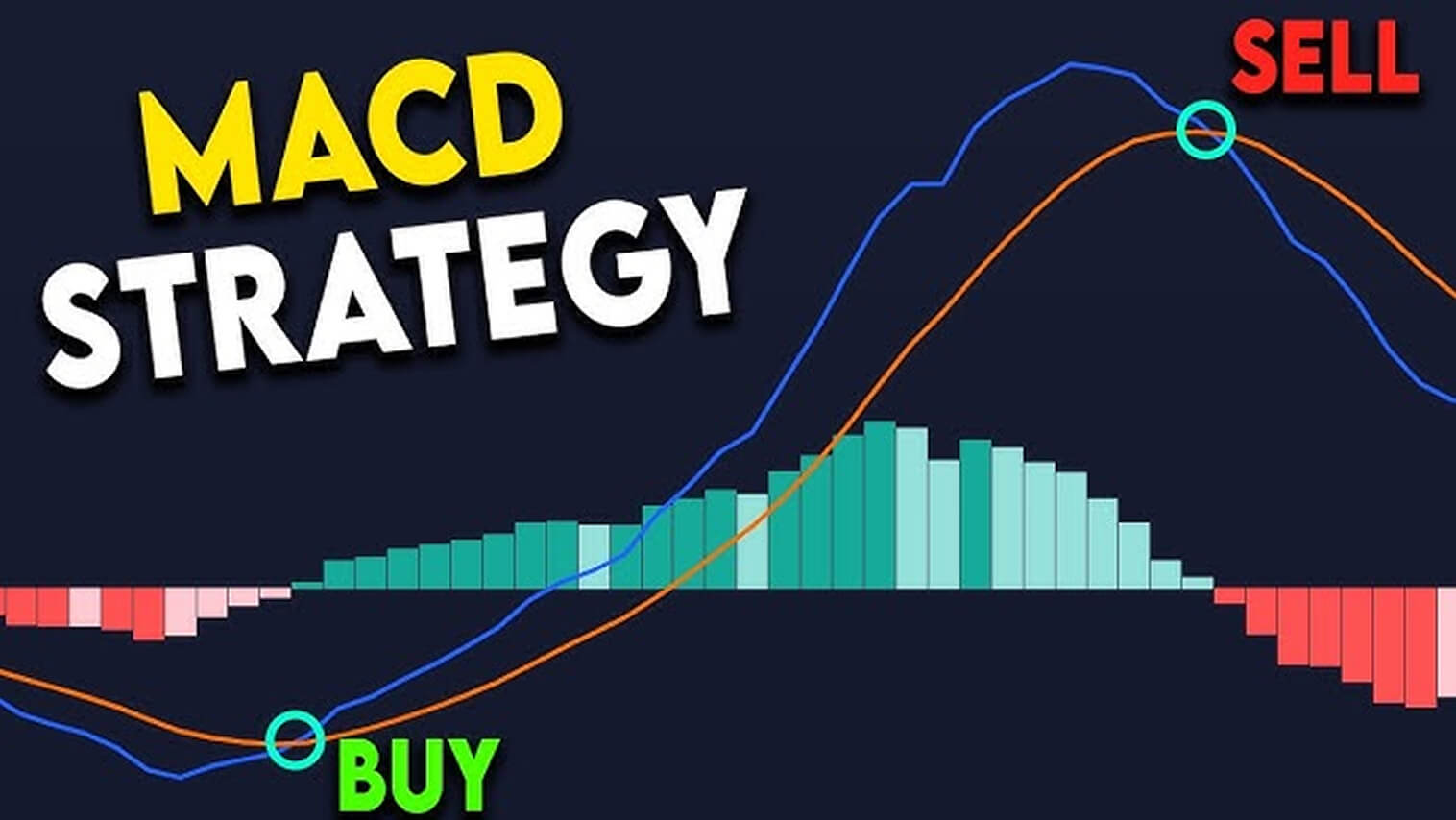
The MACD is a trend-following indicator that captures the relationship between a short-term exponential moving average and a long-term exponential moving average. A bullish signal appears when the MACD line crosses above the signal line, while a bearish signal appears when the MACD line crosses below the signal line. The histogram, on the other hand, represents the difference between the MACD and signal lines and provides relevant insights into the strength of the trend.
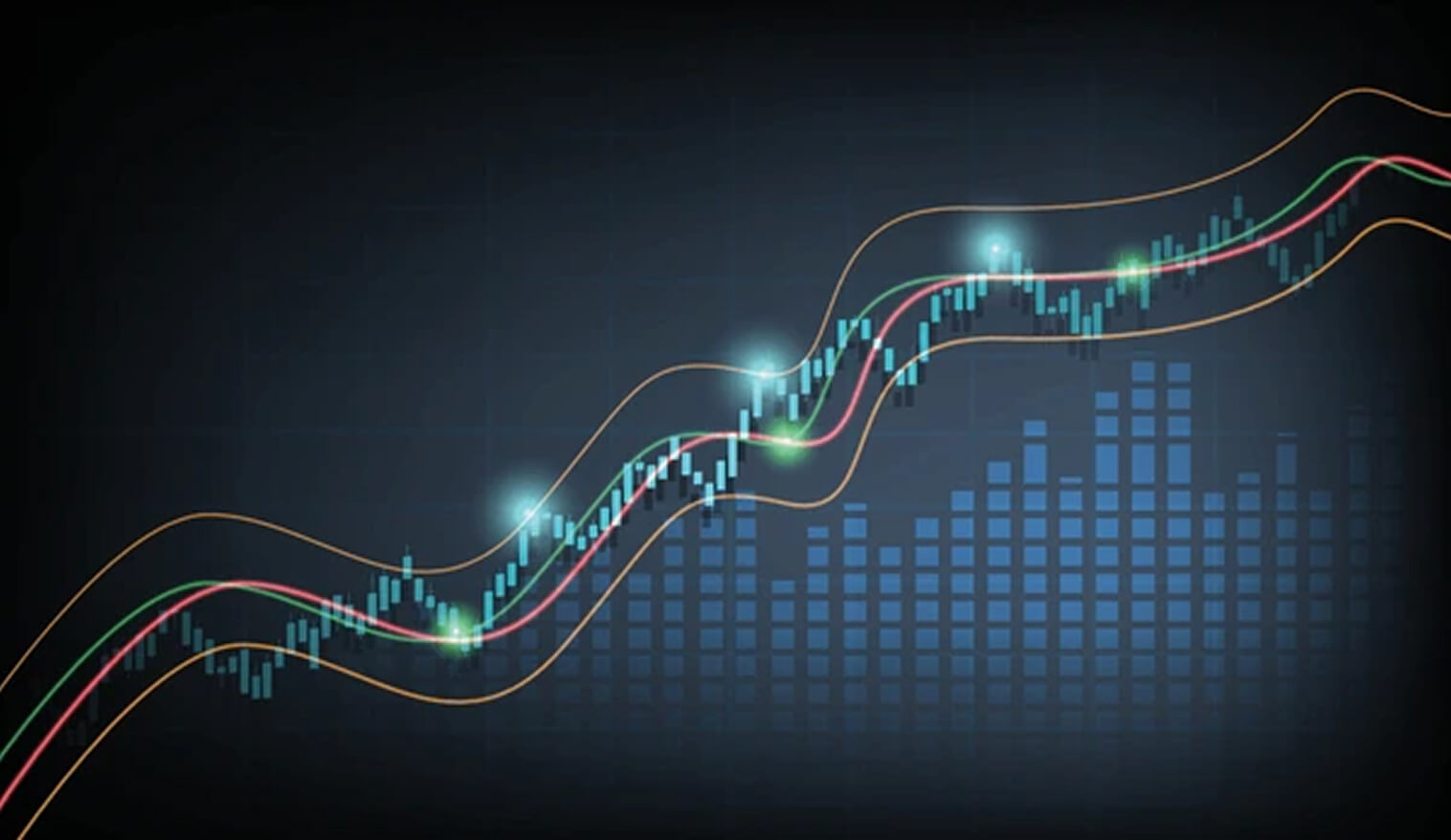
Bollinger Bands are volatility indicators consisting of a middle band – usually a simple moving average – and two outer bands a certain number of standard deviations away from the middle band – usually two standard deviations away. When a surge in volatility occurs, the bands widen, when volatility gets lower, they narrow down. Breakouts from a period of narrow bands tend to lead to explosive price movements. Some traders also use it by considering overbought conditions when prices approach the upper band and oversold conditions when they approach the lower band.
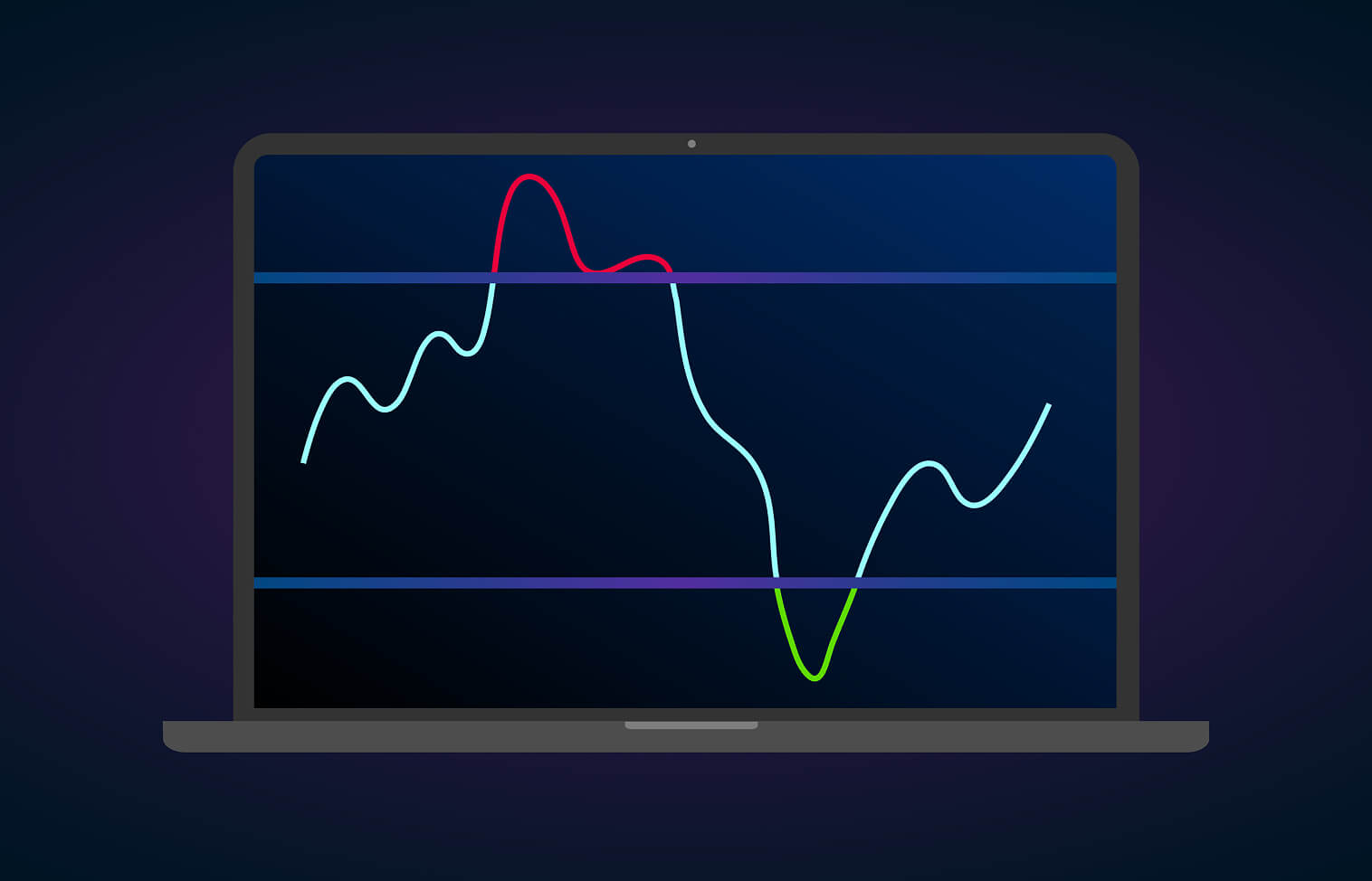
The RSI is a momentum oscillator that measures the speed and change of price movements from 0 to 100. An RSI over 70 typically indicates overbought conditions, whereas under 30 suggests oversold conditions. Some traders also look for divergences between prices and indicators to gain insights into the strength of the trend and predict trend reversals.
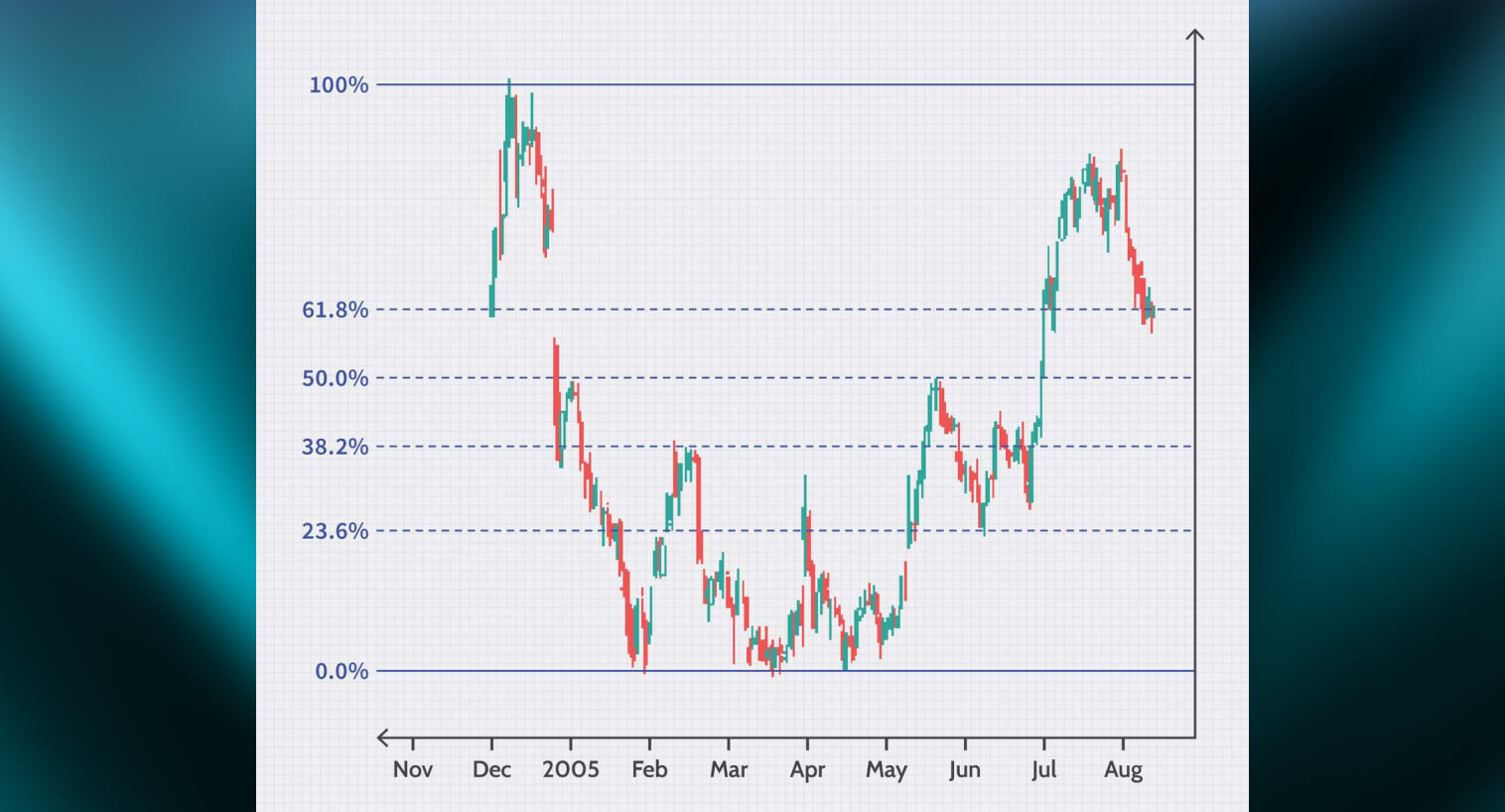
Based on the Fibonacci sequence, traders use certain retracement levels to identify dynamic support and resistance price zones. Several crypto trading strategies use Fibonacci retracements to look for price reactions at key areas where traders determine entry and exit points.
For better results, it is advised to combine signals from multiple indicators and classic technical analysis techniques, such as using trendlines in trading. Looking for confluence, where different indicators give the same signal, can highly increase the probability of a successful trade.
Several strategies can be successfully employed for swing trading cryptocurrencies. Let’s explore some of them down below:
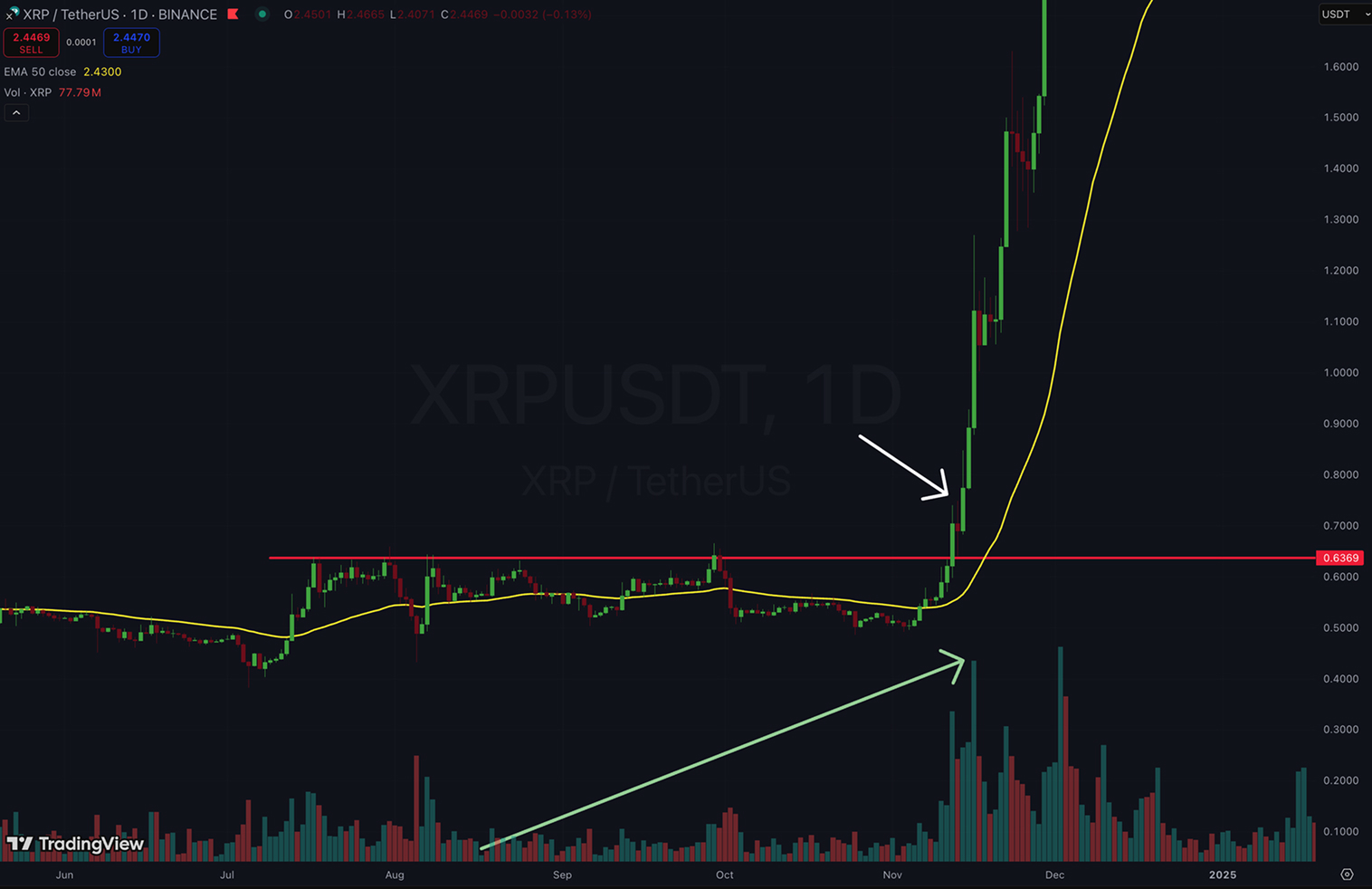
This strategy involves entering a trade when the price breaks through a significant support or resistance level. The example above shows that $0.63 served as a resistance zone for XRPUSDT from July to November. On November 12th, the price breaks through that price level with a surge in trading volume. On November 13th, the market left a red candle that then tested the former resistance level as a new support level, allowing us to enter the breakout of this day’s high. The stop loss would be at that same candle’s low, whereas the take-profit could be defined by a Fibonacci extension of the former trading range or by following a trailing stop.
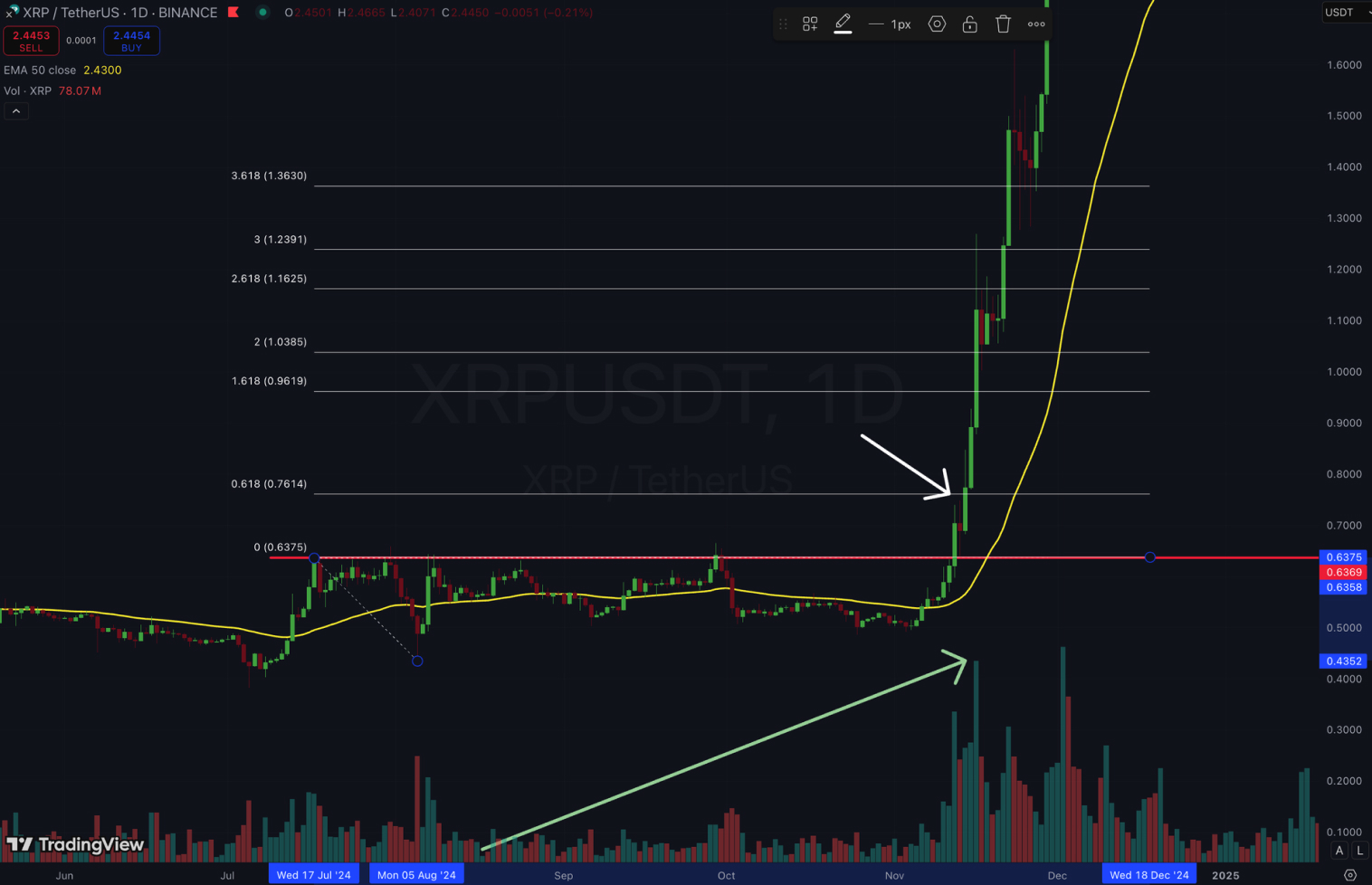
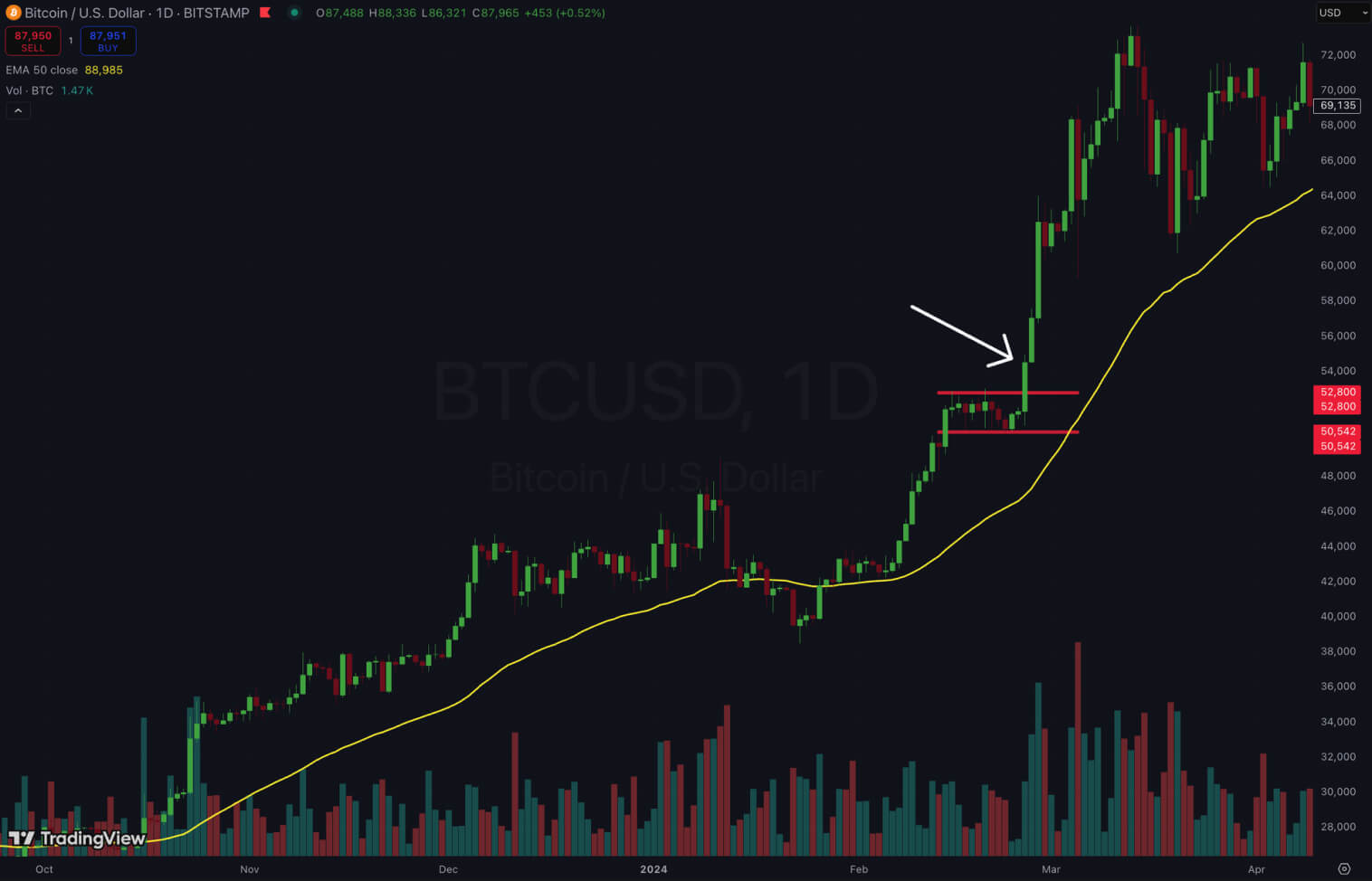
In this strategy, we only trade if the market displays a trend. This is a strategy that involves buying after a temporary price decline within an uptrend – and vice-versa amid a downtrend. In the BTCUSD example above, we can see the market in a bullish trend (prices are higher than a 50-period Exponential Moving Average), but the market slows down for a few days, as you can see by the small candles within the two red lines. This is a sign that some of the early buyers are realizing their profits, and it allows us to enter the market for the next rally. The entry point would be at the high of the candle that broke down the flag we drew with the two parallel red lines.
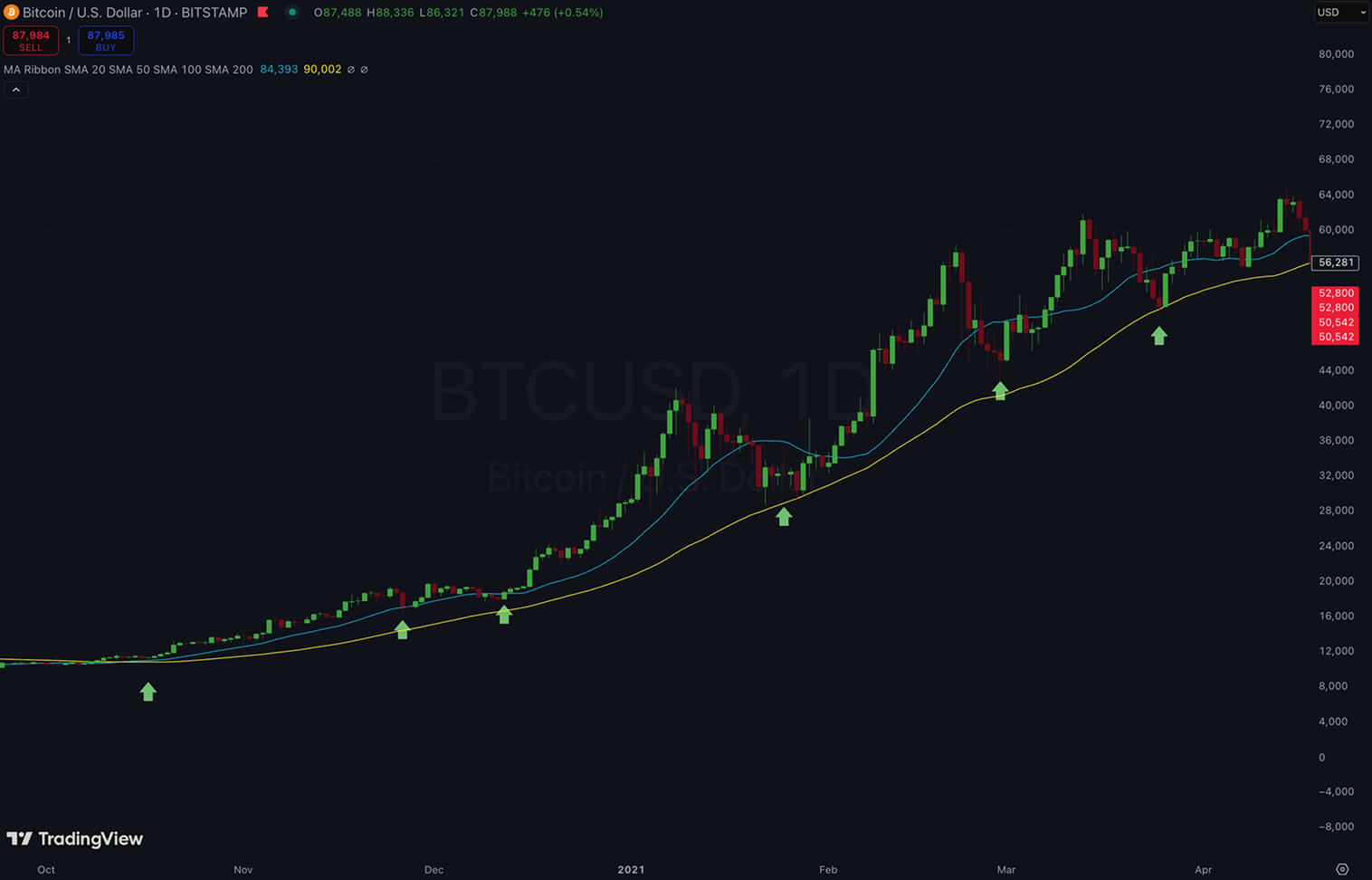
Crypto traders can use the crossover of two moving averages with different periods to generate buy and sell signals. A well-documented example is the Golden Cross, where a shorter-term moving average (50 SMA) crosses above a longer-term moving average (200 SMA) and generates a bullish signal. In the example above, a trader could immediately enter as soon as the 20 SMA (blue line) crosses over the 50 SMA (yellow line). Considering that it is risky to enter right away at the crossover, a more careful trader would find entry opportunities whenever prices touched either moving averages or stayed between them, indicating a slowdown in momentum, similar to pullbacks. This is a trend-following strategy that can work especially during long periods of an uptrend or downtrend.
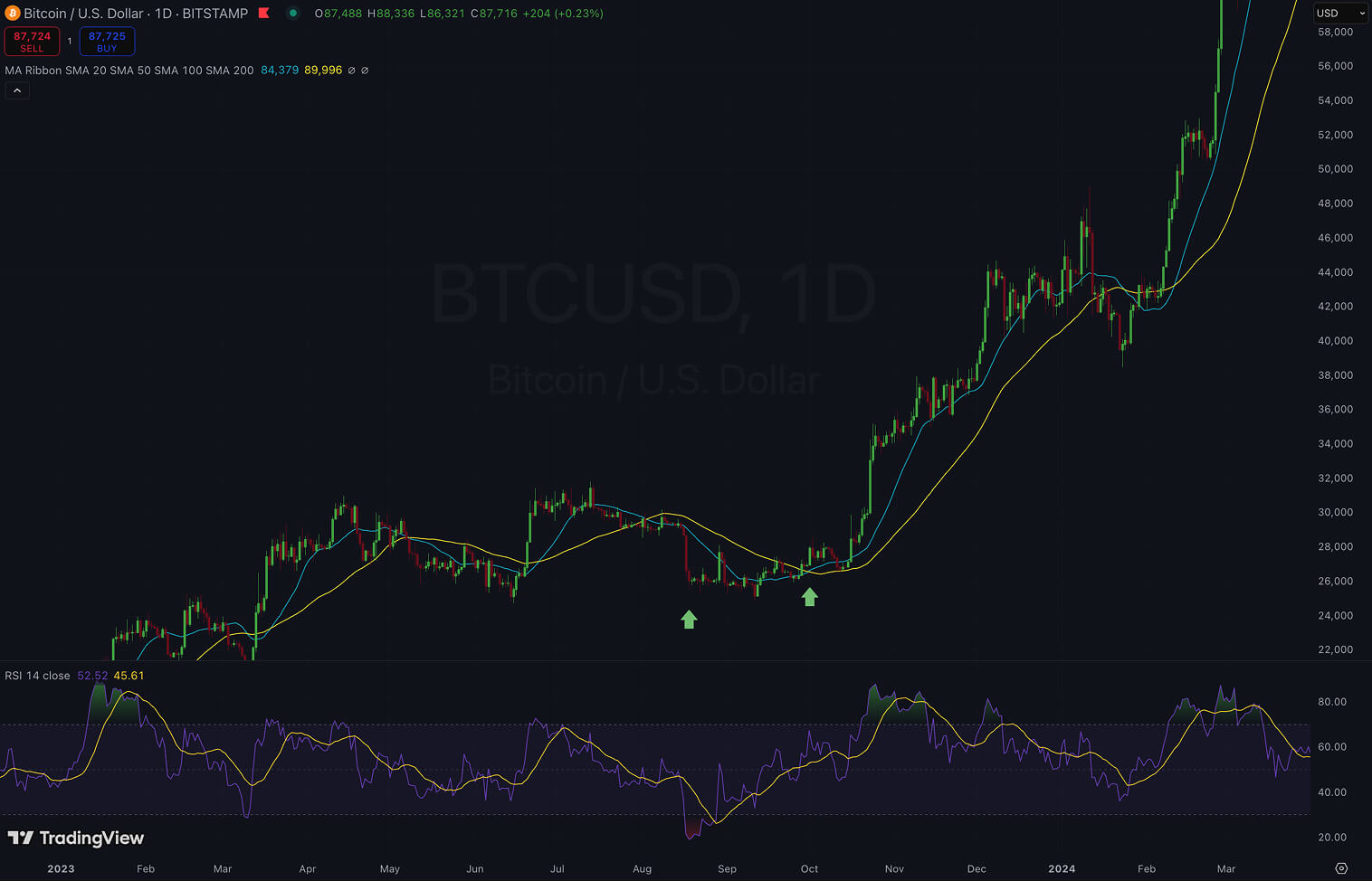
Trading with the RSI indicator involves using the RSI to identify overbought and oversold conditions and potential trend reversals. Overall, traders look for the 30 and 70 levels to stay vigilant on the possibility of a trend reversal, given that the current trend might be around an exhaustion point. It is always advisable to use the RSI alongside another indicator. In the example above, we have a confluence of signals between the RSI and the moving averages. When the RSI is below 30, you can stay more vigilant about a possible trend reversal, but most careful traders wouldn’t interpret this as a buy signal right away. A few days later, when the shorter moving average crossed higher than the longer moving average and the RSI crossed over the 30 level, most traders would find it more prudent to enter the market and go long. As you can see, the RSI reached overbought levels a few days later, but that didn’t bring prices down because there was a lack of additional signs that the buyers had reached exhaustion.
Bitcoin, as the leader in the crypto market, has its unique trading features and considerations. Its high liquidity and large market cap ensure the efficiency of trade executions. Bitcoin price volatility responds quite well and predictably to support and resistance levels, making technical analysis particularly effective, as well as the development of algorithmic trading strategies.
Chart patterns such as the head and shoulders, double tops and bottoms, triangles, flags, and wedges frequently appear on Bitcoin charts, providing insights into potential future prince swings. Bitcoin’s relationship with altcoins is also significant since Bitcoin often leads the entire crypto market, and altcoins tend to follow its direction. Given Bitcoin’s dominance, it is a must to monitor its price charts and relevant news, even if you are trading other coins.
Technical analysis tools like RSI and MACD serve as important crypto market indicators to find optimal entry and exit points when swing trading Bitcoin. They help you identify and ride trends, find overbought/oversold levels, and assess the strength of price swings.
Effective risk management is needed in any trading approach, be it day trading or swing trading. To protect your capital and ensure long-term success, your risk management system must include the following steps:
Risk management should be your number one priority for the long-term success of a swing trading plan. It is, in fact, more important than the trading strategy itself because it minimizes the impacts of losses and protects your capital – ensuring long-term sustainability. It also helps you to stay in control of your emotions during trading by removing the temptation to hold onto losing positions for way too long.
Among the most common mistakes that novice traders make, we can list the following:
If you are new to swing trading in crypto, a structured approach can increase your chances of success. We have developed a step-by-step action for all those who wish to start this trading approach:
It takes a lot of time and dedication to become profitable in swing trading. It can take anywhere from several months to a year of consistent learning and practice to develop the necessary skills for achieving profitability. Dedicate time to regularly studying technical analysis and carefully analyzing your trades to learn from both your successes and your mistakes.
Swing trading is a strategy that benefits from market volatility and price movements in the short to medium term. Unlike day trading, swing trading allows full-time traders to profit from the markets without the constant need to monitor price charts multiple times a day.
While swing trading is already widely used in stock markets, it can also be effectively adapted to the growing cryptocurrency market. By studying its core concepts, comparing it with other trading methodologies, and understanding its advantages and disadvantages, you can determine whether this approach aligns with your goals and lifestyle. Success in crypto swing trading requires a solid knowledge of technical analysis and a disciplined approach to risk management.
Although the potential profits are significant, beginners should be mindful of common mistakes and follow a structured action plan that emphasizes continuous learning and adaptation, especially in a new and rapidly evolving market like cryptocurrency.